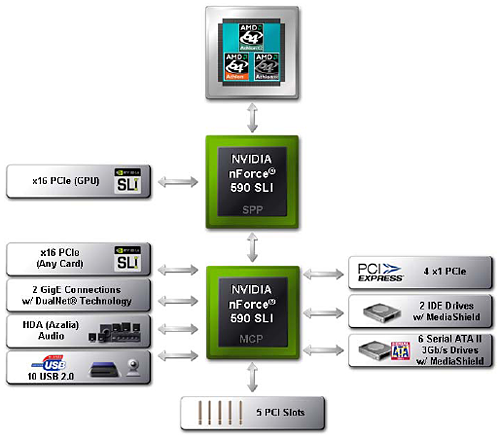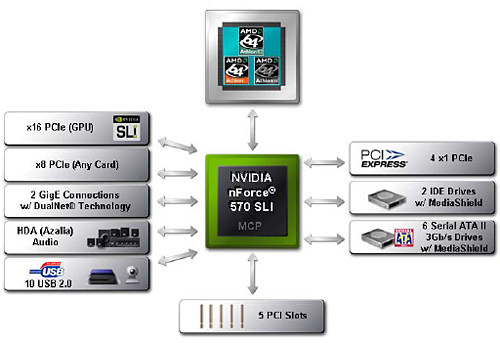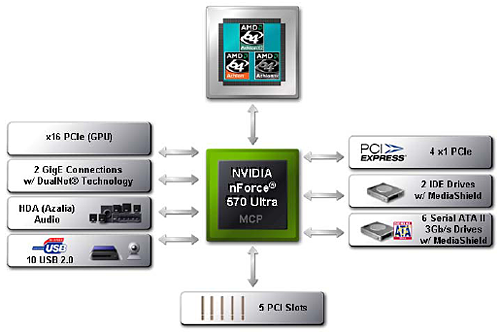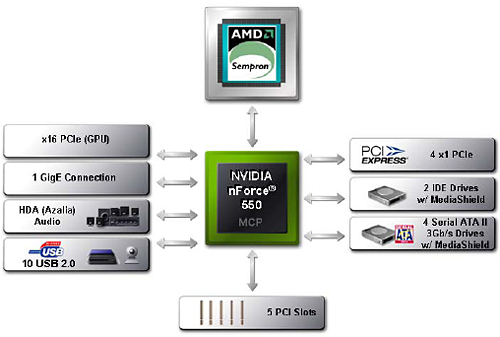nForce 500: nForce4 on Steroids?
by Gary Key & Wesley Fink on May 24, 2006 8:00 AM EST- Posted in
- CPUs
Basic Features: nForce 500 Platform
For the launch of socket AM2, NVIDIA is providing no less than four new product offerings dependent upon the market sector. With this product introduction NVIDIA is launching two new chipsets, the C51XE and MCP55PXE that form the basis for the four models. A quick summary of the new product choices can be found in the following table.| NVIDIA Chipset Breakdown | ||
| Market Segment | Socket 939 | Socket AM2 |
| High-End Enthusiast | nForce4 SLI X16 | nForce 590 SLI |
| Mainstream Enthusiast | nForce4 SLI | nForce 570 SLI |
| Performance Mainstream | nForce4 Ultra | nForce 570 Ultra |
| Value Mainstream | nForce4 4X | nForce 550 |
We expect the new socket AM2 motherboards to cost slightly more than their socket 939 counterparts, at least initially, but long-term they should have basically the same prices. The High-End Enthusiast segment will be around $200, Mainstream Enthusiast will be around $150, Performance Mainstream will be close to $100, and the Value Mainstream offerings will look to target the $80 or under market.

At the top of the product offering, the nForce 590 SLI consists of two chips, the C51Xe SPP and the MCP55PXE. This solution offers dual X16 PCI-E lanes for multiple graphics card configurations. While other features have changed, the overall design is very similar to the nForce4 SLI X16. The total number of PCI-E lanes is now 46, with 18 lanes coming from the SPP. Of those 18, two go unused at present and the remaining 16 are for the PEG slot.

One step down from the nForce 590 SLI is the nForce 570 SLI. This is a single chip solution, providing two X8 lanes for multiple graphics cards. A total of 28 lanes are of available, up from the 20 lanes that were available on the nForce4 SLI chipset. The 570 chipset also lacks the included LinkBoost technology but is otherwise the same as the 590.

The nForce 570 Ultra comes next, with a drop to 20 total PCI-E lanes. If the name didn't clue you in already, the Ultra also drops support for SLI. Basically, this is the "performance mainstream" offering, targeting users that are only interested in running single graphics cards. We do not expect a large difference in price between the 570 SLI and the 570 Ultra boards, and the $20 or so price premium might be worthwhile in order to have the extra PCI-E X16 slot. While at present only cards going into X16 slots are GPUs, depending on how long do you keep your next motherboard you might see additional options.

Rounding out the chipset offerings, the nForce 550 is the "value mainstream" product, taking over from the nForce4 4X. Several of the higher end options have been dropped from the 550 chipset, including support for dual Ethernet controllers, the FirstPacket technology, TCP/IP acceleration, and RAID 5. The number of natively supported SATA ports has also been reduced from six down to four. Whereas the other three chipsets are recommended for Athlon 64/FX/X2 users, the nForce 550 is recommended for Athlon 64 (single core) and Sempron users.
Here's a summary of the features and specifications of each chipset:
| Specification | |||||
| NVIDIA nForce 590 SLI |
NVIDIA nForce 4 SLI x16 |
NVIDIA nForce 570 SLI |
NVIDIA nForce 570 Ultra |
NVIDIA nForce 550 |
|
| Segment | Enthusiast SLI (2x16) |
Enthusiast SLI (2x16) |
Performance SLI (2x8) |
Performance | Mainstream |
| CPU Suggestion | Athlon 64 FX, Athlon 64 | Athlon 64 FX, Athlon 64 | Athlon 64 FX, Athlon 64 | Athlon 64 FX, Athlon 64 | Athlon 64, Sempron |
| SLI Technology | Yes | Yes | Yes | No | No |
| NVIDIA LinkBoost | Yes | No | No | No | No |
| NVIDIA FirstPacket | Yes | No | Yes | Yes | No |
| NVIDIA DualNet | Yes | No | Yes | Yes | No |
| Gigabit Connections | 2 | 2 - requires an external chipset | 2 | 2 | 1 |
| Teaming | Yes | No | Yes | Yes | No |
| TCP/IP Accleration | Yes | Yes, ActiveArmor | Yes | Yes | No |
| MediaShield | Yes | Yes | Yes | Yes | Yes |
| SATA / PATA Drives | 6 SATA 2 PATA |
4 SATA 4 PATA |
6 SATA 2 PATA |
6 SATA 2 PATA |
4 SATA 2 PATA |
| RAID | 0, 1, 0+1, 5 | 0, 1, 0+1 | 0, 1, 0+1, 5 | 0, 1, 0+1, 5 | 0, 1, 0+1 |
| NVIDIA nTune 5 | Yes | No | Yes | Yes | Yes |
| PCI Express Lanes | 46 | 38 | 28 | 20 | 20 |
| Links | 9 | 8 | 6 | 5 | 5 |
| USB Ports | 10 | 10 | 10 | 10 | 10 |
| PCI Slots Supported | 5 | 5 | 5 | 5 | 5 |
| Audio | Azalia | AC'97 | Azalia | Azalia | Azalia |










64 Comments
View All Comments
Googer - Wednesday, May 24, 2006 - link
http://www.hardwarezone.com/news/view.php?id=4614&...">http://www.hardwarezone.com/news/view.php?id=4614&...http://www.neoseeker.com/Articles/Hardware/Reviews...">http://www.neoseeker.com/Articles/Hardware/Reviews...
Googer - Wednesday, May 24, 2006 - link
AM2 Now Shiping at Newegg.comhttp://www.newegg.com/Product/ProductList.asp?Subm...">http://www.newegg.com/Product/ProductLi...rchInDes...
Doormat - Wednesday, May 24, 2006 - link
The media shield feature looks nice. Buy two drives for a RAID-0 array for the OS and whatnot. Then the RAID-5 array for all your important stuff (saved games, documents, pictures, etc). Having both arrays on one chipset is nice.Pirks - Wednesday, May 24, 2006 - link
Why would you penalize your write speed with RAID5 when there is RAID1? Why not get RAID1 instead of RAID5 and enjoy 1) reliability (same as RAID5) 2) speed (same as single drive for writing, faster than single drive for reading) 3) low price (no need for more than two hard drives)mino - Wednesday, May 24, 2006 - link
AND lower available capacity for the money you pay. You see 4 300G drives in RAID5 bring you 900GB of (cheap and reliable) storage. Do that with 4 drives and RAID1(or 0+1 for that) means i.e. 2x400 + 2x500 which is SIGNIFICANTLY more expensive.Remember there are guys with 10 drives, any situation you could economically justify 3+ drives for storage RAID5 is the most cost effective way.
JarredWalton - Thursday, May 25, 2006 - link
Too bad the integrated RAID 5 solutions from NVIDIA only work with 3 drives (and potentially one hot-swap). Maybe I'm mistaken, but I'm pretty sure you can't run 4, 5, or 6 drives in a single RAID 5 array using the NVIDIA controller. That's why you can do two RAID 5 arrays with 3 drives in each array. Problem is, doing RAID 5 without a lot of RAM for the RAID controller can really hurt (write) performance.nordicpc - Wednesday, May 24, 2006 - link
Something I noticed yesterday while looking through the AM2 reviews that incorporated both ATI and nVidia's chipsets was the huge disparency in power usage, some 40 watts in some cases.Charlie D. has brought this up over at the Inq aswell.
Not only with nVidia's 5x0 series do you need a huge chunk of copper with 3 pipes to eliminate the fan, but also you'll be paying a bit extra on the power bill it seems, for what? Some extra networking options that most of us never use because they are so dodgy.
Where's the power consumption page on here?
Gary Key - Wednesday, May 24, 2006 - link
They are coming in a different article as we just started receiving our ATI AM2, nF550, and other boards. The pull in by AMD was a stretch for the board suppliers who had planned on rolling the AM2 series out during Computex and shipping at that time. NVIDIA was caught trying to qualify drivers for both the video and platform side in half the time. We just received final AM2 chips on Saturday morning. ;-)
NullSubroutine - Wednesday, May 24, 2006 - link
mehfitten - Wednesday, May 24, 2006 - link
I concurr.